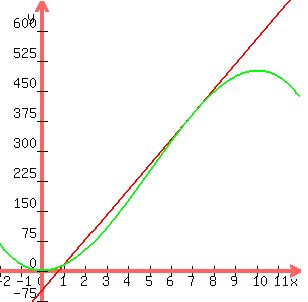|
Question 828243: hi! can u help me with these questions.? thank u!
(applications of the derivative)
1) after x weeks, the number of people(or population) living in a communitty is given by the function f(x)=2x^2-4x+100 provided that x is less than or equal to 1.
a.) what is the average rate of change of the population from the second week (x=2) to the fifth week (x=5)?
b.) find the rate of change of the population after the second week.
2) During a flu epidemic, medical researchers found out that the number of people infected in x days is given by the function p(x)=15x^2-x^3 for 0 less than or equal to x less than or equal to 10.
a.) find the average rate of infection for the first seven days (from day 1 to day 7).
b,) what was the rate of infection after the fourth day?
Answer by KMST(5328)   (Show Source): (Show Source):
You can put this solution on YOUR website! 1) after x weeks, the number of people(or population) living in a community is given by the function 
After that, you typed "provided that x is less than or equal to 1".
That does not make sense I think you meant
provided that  , or , or
provided that x is greater than or equal to 1.
a.) The average rate of change of the population from the second week (x=2) to the fifth week (x=5) can be found by dividing the difference in population by the number of weeks passed.
So, in  weeks the population went from weeks the population went from
 to to

The average rate of change of the population from the second week (x=2) to the fifth week (x=5) is

That average rate is the slope of the line connecting the points for  and and  on the graph. on the graph.

b.) find the rate of change of the population after the second week.
At the point  (after the second week, the change of the population is given by the value of the derivative of f(x) at (after the second week, the change of the population is given by the value of the derivative of f(x) at  . .
If you have been taught about derivatives, you would know that the derivative of  is is
 
and for  its value is its value is
 
That rate at the point with  is the slope of the tangent to the graph at the point with is the slope of the tangent to the graph at the point with  . .

2) During a flu epidemic, medical researchers found out that the number of people infected in x days is given by the function  for for  (for x between 0 and 10, inclusive) . (for x between 0 and 10, inclusive) .
(Clumsier alternative wordings:
for x greater than or equal to 0, but lesser than or equal to 10,
or if you want a more unwieldy mouthful, for x such that 0 is less than or equal to x, and x is less than or equal to 10).
a.) find the average rate of infection for the first seven days (from day 1 to day 7).
As done above,
 , and , and


b) what was the rate of infection after the fourth day?
The derivative is
 
and for  its value is its value is
 
That rate at the point with  is the slope of the tangent to the graph at the point with is the slope of the tangent to the graph at the point with  , with , with  . .
The graphs of  with one or the other line are shown below. with one or the other line are shown below.

 It's hard to see that the line at left is the tangent at It's hard to see that the line at left is the tangent at  , but a close-up does not help much either. The function is almost a straight line in the vicinity of that point. , but a close-up does not help much either. The function is almost a straight line in the vicinity of that point.
|
|
|
| |